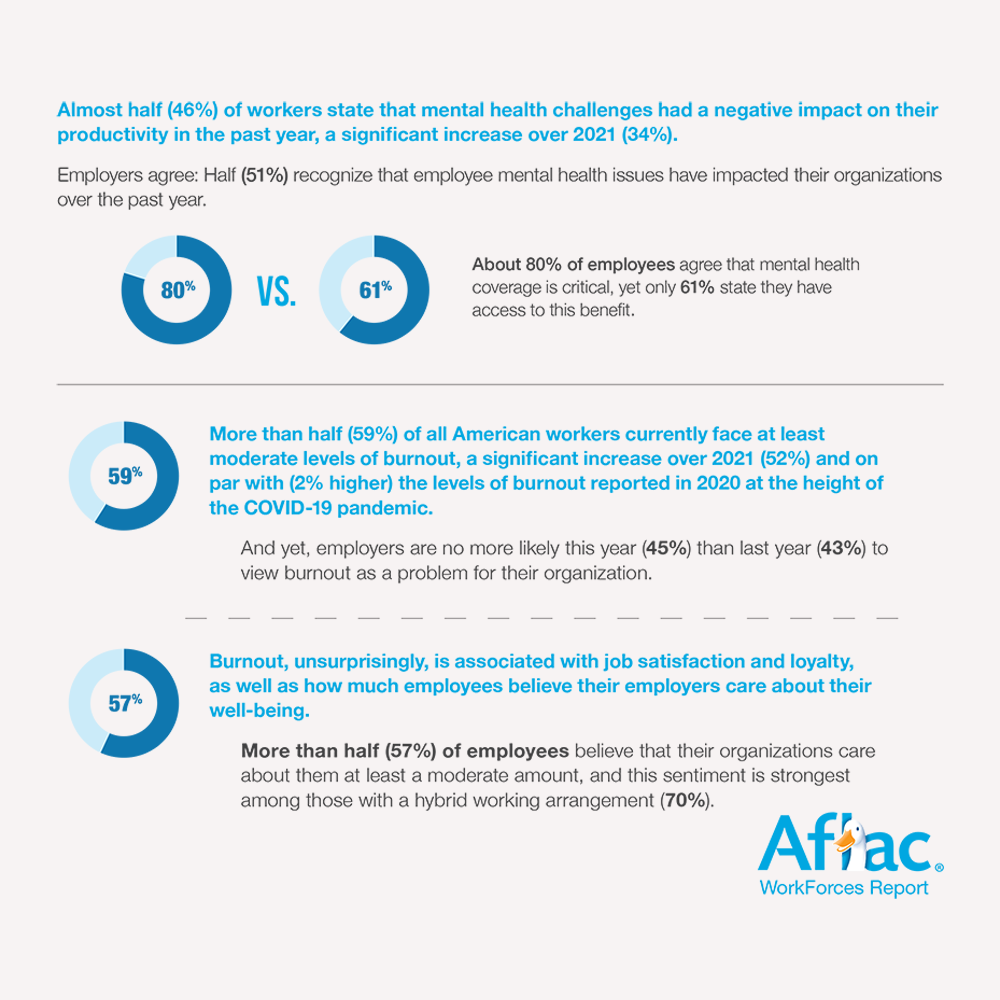Let’s talk about employee burnout.
Half of the employees in the US reportedly experience burnout. Globally, it is as high as 70% of employees. I open with these statistics for two reasons. First, to illustrate the scope and scale of the problem. Second, to highlight the ineffective way we tend to approach this issue. Burnout is a systemic problem, but when we talk about solutions, we tend to focus on what we, individually, can do to improve our well-being. Conversations begin and end with self-care. While self-care is and will always be necessary, it doesn’t address the drivers of workplace burnout. That requires systemic changes in the work environment.
Recognizing this and acknowledging my experience with burnout throughout my career (and in the past year specifically), I spent time researching and reflecting on workplace burnout over the last few months
Drivers of Workplace Burnout*
While there are many drivers of workplace burnout, there are six primary drivers or indicators of burnout that everyone should be aware of within a workplace.
The Diminishing Returns of Doing More with Less
By design, Atrómitos is a small team. This means that while our bench is deep in experience and expertise, there isn’t the same depth in manpower to spread the workload. We are also individually and collectively high achievers that strive for better. A combination that can lead to one of the drivers of employee burnout – unsustainable workload.
As the leader of Atrómitos, I am responsible for the team’s workload, planning for, and managing it. It’s incredible what people can make happen when there are limited resources and capacity. But even the most remarkable can’t sustain doing more with less for an extended period, much less for an undefined period. Employers and managers need to ask themselves not only what can be done but also, what can be done repeatedly, reliably, and consistently.
Let’s be clear–those are not the same things.
Locus of Control
Employers often think that providing recognition to employees who have and continue to do their job well is through compensation, including merit raises and bonuses. To a certain extent, I understand that. But it is wholly inadequate. Humans need recognition.
This is a difficult one for me. I, personally, am not comfortable with recognition. As a result, I often have not given recognition to others. This has been an issue not just in my professional relationships but also in my personal ones. I learned, or maybe it was that I finally understood, the importance of recognition from my 11-year-old son, courtesy of the homeschooling we are engaging in. For my son, it didn’t matter if he checked everything off the to-do list and got good grades on his assignments, quizzes, and tests. At the end of the day, he would ask me, “Did I do a good job?” He needed my acknowledgment of a job well done. Failure to provide this recognition leaves people wondering, “why do I bother?” or they continually try to do more or better. Either way, a lack of recognition contributes to burnout.
Lack of Community
Humans are fundamentally social, collective creatures, and our work environments do not always support that. We are experiencing an “epidemic of loneliness,” which is having a considerable impact on work. “More and more people are feeling tired and lonely at work….” For many, especially in the US, our work and our work-community are core components of self. We tend to define ourselves by our jobs and the work we do. Given this fundamentality of our work, when we feel isolated and disconnected in that environment, it’s no wonder we can feel shaken to our core.
Let’s be clear, I do not mean this requires everyone to be back in an office or other shared physical location. Atrómitos is, always has been, and always will be a company that operates 100% remotely. You can feel isolated sitting in an office with 600 people, and many are. What employees want, and need, is a community. That includes a “network of support, honesty, and shared accountability.” Community denotes a sense of belonging, shared purpose, and mutual support. Lack of a community can be emotionally devastating and certainly drives burnout.
Lack of Fairness
“It’s not fair!” Every parent has heard this more than once. I might have been the queen of “that’s not fair” growing up. My son certainly is. Why?
Well, it’s because fairness and justice are closely linked. How does this apply in work?
We’ve all experienced a situation in which we work really (really) hard, and a colleague doesn’t. Yet, that colleague receives the same recognition (or worse, more) than we do. Or, we have the same job title and responsibilities as someone, but their compensation is more than we receive. This lack of fairness causes frustration and anger and erodes a sense of reciprocity and respect.
Lack of Alignment with Core Values
Atrómitos is a company with very strong principles, values, and views. It is necessary that team members align with those. Additionally, consulting is a practice that requires particular skills and capabilities. When we bring on new team members, we seek candidates who align with our values and have the skills needed for consulting. This hasn’t always gone as hoped. We know from experience that when companies and their employees are unaligned on values or skills and capabilities needed, this misalignment will drive burnout. For me, this is among the most critically important driver of burnout.
Why this Matters, Quantifying the Impact of Burnout
One of the most surprising things I’ve read recently is a finding in the 2022-2023 Aflac Workforce Report, in which they report that almost half of employers do not view burnout as a problem in their organization.

Given the high burnout rate among employees in the US, this is startling, because the impact of burnout is significant. For individuals, workplace burnout leads to physical exhaustion and increased likelihood of many chronic conditions, including heart disease, diabetes, and high blood pressure; depression, anxiety, irritability, and anger; it is highly disruptive to personal and professional relationships.
For businesses, employee burnout means reduced productivity, increased errors and mistakes, poor communication with customers and team members, and turnover. High turnover rates and bad company reviews by current and former employees make bringing on new team members more challenging. Also, candidates going through the interview process pick up on the vibe that not all is well at a company when its workforce is experiencing burnout.
Given the increasing burnout rate among employees, I highly encourage employers to reevaluate what this means. For those employers that are lucky enough not to be experiencing this, pay attention to what you need to do to continue that trend. Saying it isn’t happening here and moving on is a good way to miss it when it happens.
What is needed
First, we must acknowledge and talk about burnout. Then we have to talk about how to address it. Finally, we need to implement systemic, organizational changes to have a meaningful impact.
I speak from experience.
In October, I brought my leadership team together and disclosed my burnout and its impact on my health, work, and relationships. I acknowledged theirs and asked them to work with me one-on-one to find a path to address theirs. I’ve since had follow-up meetings with team members to find ways forward.
For me, my burnout resulted from losing the why of my company. This is directly related to the lack of control and feeling like I wasn’t making any impact. In healthcare, change happens slowly, and even after the change happens, in time, we tend to fall back into old patterns. When you’ve been doing this work for twenty years, and you’re dealing with the same issues you were when you started your career, you’re bound to have a moment of “why do I bother?”
My moment was this year.
The good news is that amidst the many things that I can’t control, I have the power to find my why again. Through our company-wide annual planning process, I’m doing that.
What we are doing at Atrómitos in 2023
The Atrómitos team is small, which makes it much easier for me to identify and address burnout among the team. It will require a different approach for larger companies with bigger teams managed by multiple managers. In their article, “Talking about Burnout is Still Taboo at Work,” authors Keith Ferrazzi and Jacinta Jimenez provide a process that may work for larger companies. Whatever process you follow, it’s time to discuss workplace burnout and address the underlying systemic drivers.
In 2023, we will emphasize our organizational culture and conduct an organizational culture assessment in the year’s first quarter using a validated and standardized tool. The assessment results will drive a process to protect the parts of our culture that are important to who we are and to identify what must change. An important part of our culture that we will focus on is accountability. Flexibility and autonomy are fundamental tenants of Atrómitos. They can seem contradictory to accountability, but they aren’t. In fact, you can’t have flexibility and autonomy without accountability.
Another priority is to achieve a more manageable workload. We like to say we are a small but mighty team. To continue to meet internal and external demand, we must grow. Everyone knows that hiring right now is really difficult. While I will continue to prioritize this, the focus is finding the right people, not just any people. That will take time.
In the meantime, my focus is to find ways to manage the current team’s workload to ensure we continue to meet client needs, meet internal operational needs, and not overextend the team. One area we will focus on in 2023 is a high-documentation, low-meeting approach to work. Internally, we already have very few meetings.
I hate meetings.
Not having meetings does not mean that I do not communicate and engage with my team. Collectively, me and team members communicate and engage with each other throughout the day. Meetings are appropriate when there is a highly complex issue, often involving emotional complexity, and when a high degree of collaboration is required to achieve an outcome. Otherwise, documentation of thinking, approach, needs, and barriers, using intentional, quality writing, is sufficient. The writing process makes people slow down and think about what they are saying or asking. It also provides a record of decision-making and commitments.
So, if we already meet infrequently, why is 2023 different? Well, it’s because we will also implement this approach with our clients. This will be an adjustment, but I’m confident it will be appreciated and valued. It will provide additional transparency and accountability, and it will come at a lower cost.
*Sources
Christina Maslach and Micheal P. Leiter, “The Burnout Challenge: Managing People’s Relationships with Their Jobs,” November 15, 2022, https://www.theburnoutchallenge.com/


